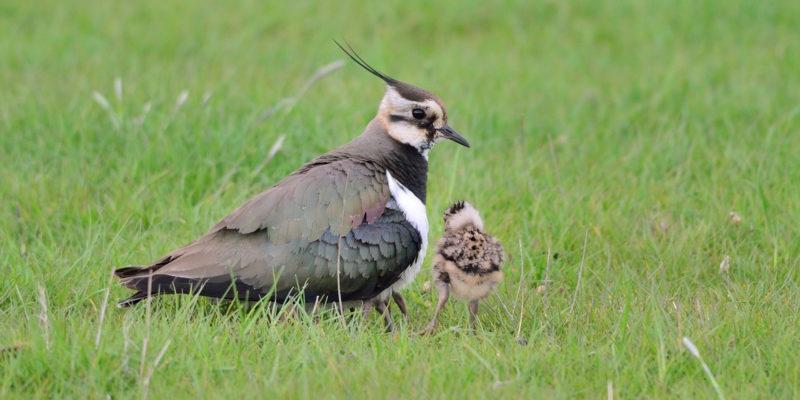- 19/07/2019
- Nature Notes
Breeding Lapwing Survey Results for Elmley National Nature Reserve - April to July 2019
2019 has ended up as another fantastic breeding season for lapwing, redshank and host of other ground nesting birds at Elmley after record breaking results last year. 336 pairs of lapwing managed to fledge over 429 chicks between April and July, a productivity of 1.2 chicks fledged per brood. An incredible result! The detail below show the full story as recorded by independent surveyors, led by Mr R. Poppe, using the Bolton et al methodology - one count every 3 weeks undertaken five times over the breeding season.
The surveyors systematically cover the whole 3000 acres of wet grazing marsh at Elmley NNR in an effort to identify adult lapwing and their chicks at each stage of development from individual adults to nesting and through chick development to fledging using a peer reviewed and recommended methodology created by Bolton et al. During the survey they also record the number of adult birds for other species such as redshank, skylark and yellow wagtails.
The very mild weather of February and March prompted many birds to pair and breed almost two weeks earlier than usual. This meant the first chick spotted was in the first week of April almost two weeks earlier than the normal, around 16th. This had a knock on effect to predation as large numbers of Mediterranean Gulls were still present on the marsh and Swale. The dry conditions meant rather than the gulls hoovering up worms they developed a taste for wader chicks. Many of the first broods of four chicks, totaling almost 100 chicks were all taken by pairs of Med gulls. Luckily the lapwing showed remarkable tenacity and with time on their side before the marsh dried and grass grew they re-laid and produced fledged chicks from their second broods. This is again a real rarity at Elmley.
To put this year's results in some perspective 2019 is the second best productivity result over the last ten years and means Elmley has again contributed a surplus number of birds to the local lapwing population. The weather plays a critical role but to achieve these results the habitat including water levels, sward height and density, micro-topography etc has to be right. In addition, these ground nesting birds benefit from low densities of key predators including foxes, corvids, stoat and hedgehog (voracious eggs eater which are live trapped and relocated to suitable local habitat).
| Bolton et al methodology – Lapwing Survey 2019 | ||||||
| Surveyor - Mr R. Poppe and R. Brookes | ||||||
| Period 1 | Period 2 | Period 3 | Period 4 | Period 5 | ||
| 08-12/04/2019 | 28/4-03/05/19 | 19-24/05/19 | 10-14/06/19 | 01-02/07/18 | ||
| Birds | 673 | 590 | 537 | 354 | 27 | |
| Birds Alarming/Behaving as if with Chicks | 0 | 66 | 35 | 24 | 3 | |
| Birds with chicks | 6 | 192 | 253 | 174 | 0 | |
| Chicks | 22 | 276 | 48 | 12 | 0 | |
| Chicks Part grown | 0 | 108 | 23 | 13 | 0 | |
| Chicks well feathered | 0 | 0 | 69 | 11 | 0 | |
| Chicks Fledged | 0 | 0 | 221 | 202 | 6 | |
| Birds sitting on eggs | 147 | 31 | 17 | 7 | 0 | |
| Elmley NNR Totals | 336 | |||||
| Fledged chicks | 429 | |||||
| Total productivity | 1.27 |
Other Ground Nesting Breeding Birds
These figures are recorded during the Lapwing survey and indicate breeding adults as total numbers or singing/displaying males. Redshank are clearly a outstanding success too with over 500 adult birds recorded the marshes were literally covered in broods of redshank chicks this Spring. Great to see Skylark and avocet in three figure numbers. An odd note were shovellers as we usually hold at least 20-25 pairs but they seemed to disappear by mid-June we suspect owing to breeding earlier than normal.
| Redshank | Oystercatcher | Yellow Wagtail | Skylark | Ring Plover | Avocet | Shoveller | |
| male | singing male | ||||||
| 8-12 April 2019 | 440 | 95 | 8 | 53 | 5 | 50 | 92 |
| 28/4 - 3 May 2019 | 474 | 120 | 87 | 103 | 2 | 54 | 51 |
| 19-24 May 2019 | 567 | 117 | 54 | 111 | 0 | 94 | 44 |
| 10-14 June 2019 | 577 | 164 | 62 | 168 | 0 | 120 | 0 |
| 1-2 July 2019 | 19 | 72 | 24 | 68 | 2 | 71 | 0 |
Thank you to all the team who's hard work and dedication over the winter has set the conditions for a wonderful Spring this year. A huge thank you to Richard Poppe for five years of excellent independent surveying of our wintering and breeding birds, he has contribute a huge amount of data on waders, not least half of the figures for the longest running breeding wader project in the UK.
